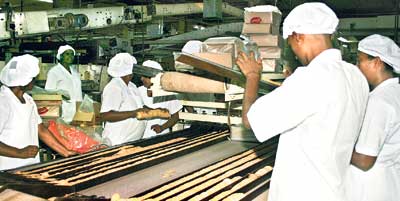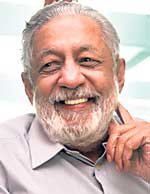
Ceylon Biscuits - Zest to be on top
Pannipitiya - He is the only one who can taste a biscuit and say what is wrong or right with it. It is not so much a case of biscuits being in his blood, but years of experience, acquired skill in biscuit manufacturing and above all the zest to be on top of things. All the above zeroes down to Mineka Wickramasingha or Micky as he is fondly known, the Chairman of Ceylon Biscuits Limited (CBL), the manufacturers of the popular ‘Munchee’ brand. As I walk into CBL in Pannipitya, the air is not that of a biscuit factory reeling with that strong baking aroma, but that of a plush, avant-garde office which perhaps deals with stock markets. The expanse is vast and clinically clean. The story of CBL is a long and interesting one, as with all good ventures. The Wickramasingha family was certainly not biscuit manufacturers. They were planters – that is Simon Arthur Wickramasingha (1902 – 1984) when he took over a small business factory in 1939 from a local businessman called Williams. Williams faced financial difficulties with his handmade biscuit operation. 1930s was a time when all biscuits were imported. Arthur started Williams Confectionary Limited or ‘Williams’ with 10 employees at Dehiwela and mechanised it in 1957. I met M.P, Mineka Wickramasingha, who had initially tried his hand at tea – tasting, as the family was involved in it, but was not good at it. “I turned to the biscuits business, Williams, which had by then been somewhat neglected, but had untapped growth potential,” he said.
It was not exactly the ‘knack’ he had, but initially more to do with his sound education in the field, as he had studied biscuit manufacturing in India, followed by two years of formal studies in food technology at Borough Polytechnic, now London South Bank University. “Subsequent to some internship with bakers in UK and Germany, I joined Williams as Production Director in 1961,” Wickramasingha said. He was bursting with ideas, saw the potential this trade had and wanted to expand. “Going through red tape for expansion was impossible, but CARE, an agency for poverty alleviation, did a study on biscuits and how they could improve the nutrition of local school children,” he reminisced. Wickramasingha had seen ‘nutritional biscuits’ as an opportunity to further expand Williams. Through sheer persistence, he did a proposal for CARE to develop a high – protein biscuit that were in line with the agency’s requirements, which subsequently led to Williams launching two pilot projects. As with many things, the government took the ‘longer’ route and despite Wickramasingha’s initiative had awarded the project through a tender process.At the time the market leader, Maliban was uninterested, and Williams secured the project. He said this contract was what helped CBL, as it moved the company from its one tonne plant to an nine tonne plant with a 27 tonnes per day operation within six weeks of starting business. “We started this in 1968 and ran three shifts a day. In 1971 we declared a 105 percent dividend to the shareholders which included workers, who had five percent in the company.” “In the 70’s we launched ‘Munchee’ which had six different types of biscuits of which two were our own innovations – Hawaiian Cookies and Milk Short Cake,” he said. He said CBL seized an opportunity in 1981 when a British biscuit giant, Associated Biscuits Limited (ABL) wanted to enter the local biscuits market looking for a potential local partner. “The tie up ensured that Munchee brand name was established,” Wickramasingha said. He reminisced that competing with the then number one player was a Herculean task. “We attacked them on generic products such as Chocolate Crème, Marie, Cream Crackers, Lemon Puff and Nice Biscuits.” He added that Lemon Puff was ‘revolutionized’ by CBL. “Earlier it was just a cracker biscuit. I had a friend, Edward Chong who was the agent for Nabisco, the world’s largest biscuit manufacture. He never bought my biscuits. After some years, I asked him why and he said the day you can make a Lemon Puff as good as Nabisco Yamasaki I will buy your biscuits. What he meant was the quality had to be improved,” Wickramasingha remembered. He said it took two years to make a Lemon Puff that good. “Edward still buys our biscuits.” He said innovating new generic products was how Munchee broke the market to become the number one brand.“We completely strengthened our quality standard. We have three distribution chains, one for chocolates and cakes, one for biscuits and the other for Samaposha and Soya products. We have the best distribution chains in the country.” While CBL was getting these areas right, Wickramasingha said that the company had noted they had an ‘image’ gap. “We spent a lot of money and built our image, which immensely helped our sales.” CBL was also the first industrialist to venture to India.” We bought Parry’s Confectionary based in Pondicherry, in India and set up Ritzbury India. We then entered the Indian market with Munchee and Ritzbury brands.”Two years ago CBL bought India’s third largest biscuit manufacturing factory in Patiala, North of Delhi, (in Punjab). Subsequently they dissolved Ritzbury India, as they wanted to concentrate more on the second acquisition. Today, the CBL Group is an active player in the Asian region with its brands present in 39 countries, contributing Rs. 14 billion in annual turnover, which is rising. Wickramasingha noted that CBL is aggressive on all fronts – be it marketing, manufacturing or acquisitions. “We want to be the number one player in the SAARC region. We are not ‘Onna Menna’. We are always at it.” The processing of Pure Kitul Treacle and Jaggery, another such project is now well under way with the products finding export markets. Wickramasingha said the company’s immediate plans involve Pakistan, Bangladesh, further expansion in India and also to go to the eastern province in Sri Lanka. Asked how CBL became No 1 in all their product range, he firmly said, “ CBL is a team - it’s the team from Directors to Senior Managers and managers and all the workers make us the NO 1 team – the collective effort.” |
|
||||||
|
||||||
| || Front
Page | News
| Editorial
| Columns
| Sports
| Plus
| Financial
Times | International
| Mirror
| TV
Times | Funday Times || |
| |
Reproduction of articles permitted when used without any alterations to contents and the source. |
© Copyright
2008 | Wijeya
Newspapers Ltd.Colombo. Sri Lanka. All Rights Reserved. |

